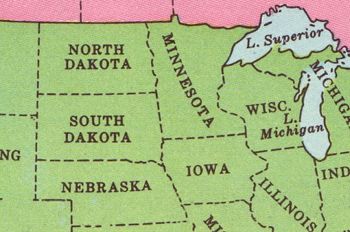South Dakota (U.S. state)
South Dakota is one of the states constituting the United States of America; it entered the Union as the 40th state on November 2, 1889, the same date as North Dakota. Its area is 77,116 square miles (199,730 square kilometers). Its estimated population in 2008 was 804,194. South Dakota is a Great Plains state bordered on the north by North Dakota, on the east by Minnesota and Iowa, on the south by Nebraska, and on the west by Wyoming and Montana. The state is split by the upper Missouri River into "east-river" and "west-river" regions. The capital is Pierre.
Land
Physiography (land forms)
South Dakota is divided into three separate regions. The main division is demarcated by the Missouri River which flows through the center of the state from north to south dividing the state into an eastern and a western region.
The eastern poriton of the state was formed by glacial deposition and is generally flat with a very slight rise as one travels from east to west.
West of the Missouri, the land continues to rise, but at a slightly steeper rate, from about 2000 feet above sea level at the Missouri River to over 3000 feet in elevation in the extreme northwest part of the state. This region is part of the Great Plains.
The third distinct region is the Black Hills area in the southwestern part of the state. This is a mountainous region, covered by a pine forest, and was sacred to the native peoples of the Great Plains.
Rivers and drainage, lakes
Climate
Soil
Flora
Natural resources
Demographics
- including native peoples
Politics and government
Elected officials
For most of its history, South Dakota has been a strongly Republican state. Since World War II, the state has voted Democratic in the quadrennial Presidential elections only once (1964) and the Governor's office has been occupied by a Republican for all but 9 of the past 74 years.
The current governor of the state, M. Michael Rounds, a Republican from Pierre, is in his second term of office, having been elected to the post in 2002 and re-elected in 2006.
The state legislature is elected from 35 districts, each of which elects 2 members to the state House of Representatives and 1 member to the State Senate. Currently the state House of Representatives consists of 46 Republicans and 24 Democrats while the state Senate consists of 21 Republicans and 14 Democrats.
Finance and taxation
current issues
Economy
Agriculture and livestock
industry (manufacturing)
Mining
Transportation
Social, cultural, and educational
Education
The University of South Dakota, situated in Vermillion, opened in 1882. South Dakota State University in Brookings was established in 1881.
Media
Libraries
Arts
Religion
Parks and recreation
Points of interest
The most important tourist attraction of the state is Mount Rushmore National Memorial, in the Black Hills. Here 60 feet (18 m) high heads of four former United States presidents can be admired: George Washington(1732–1799), Thomas Jefferson (1743–1826), Theodore Roosevelt (1858–1919), and Abraham Lincoln (1809–1865).
